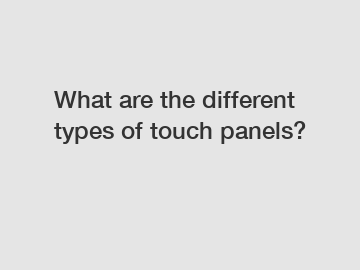What are the different types of touch panels?
Finelink Product Page
In today's fast-paced digital world, touch panels have become an integral part of our lives. From smartphones and tablets to ATMs and self-service kiosks, touch panels have revolutionized the way we interact with technology. But have you ever wondered what goes on beneath the surface? In this blog post, we will delve into the fascinating world of touch panels and explore the various types available in the market, offering you a comprehensive understanding of this cutting-edge technology.
Understanding Touch Panels:

Touch panels, often referred to as touchscreens, are user-friendly interfaces that allow direct interaction with electronic devices through physical touch or gestures. There are several types of touch panels available, each utilizing different technological approaches to enable touch-sensitive characteristics.
1. Resistive Touch Panels:
Resistive touch panels are one of the oldest and most commonly used touch technologies. They consist of two electrically conductive layers separated by tiny spacers. When pressure is applied to the screen, the top layer comes into contact with the bottom layer, establishing a circuit and determining the touch points. These panels are inexpensive and offer accuracy, but they are not very durable and tend to be less responsive than other types.
2. Capacitive Touch Panels:
Capacitive touch panels have gained tremendous popularity due to their enhanced sensitivity and durability. They work based on the electrical properties of the human body. A transparent electrode layer covers the glass surface, and when a finger approaches the screen, it creates a capacitance change. This change is detected by the panel, allowing the user to interact directly. Capacitive touch panels offer multi-touch capabilities, allowing for gestures such as pinch-to-zoom and swiping.
3. Infrared Touch Panels:
Infrared touch panels utilize an array of infrared light-emitting diodes (LEDs) and photodetectors to create an invisible grid over the screen's surface. When an object, such as a finger or stylus, interrupts the infrared light beams, the corresponding coordinates are identified, and the touch position is registered. This technology offers excellent accuracy, durability, and resistance to dust or scratches, making it ideal for high-traffic environments.
4. Surface Acoustic Wave (SAW) Touch Panels:
SAW touch panels function by sending ultrasonic waves across the screen's surface. When the panel is touched, some waves are absorbed, creating a change in the wave pattern. This alteration is detected by receivers, determining the touch points. SAW touch panels offer outstanding clarity, high image quality, and excellent touch response. However, they are sensitive to environmental factors like dirt, moisture, and contaminants.
5. Optical Imaging Touch Panels:
Optical imaging touch panels employ cameras or infrared light sources and sensors to identify touch points. When the screen is touched, an optical effect is created, which is detected and processed to determine the touch location. These touch panels offer high accuracy, excellent image quality, and resistance to external factors. They can also detect non-conductive objects like gloved hands or styluses, making them widely used in industrial settings.
Conclusion:
Touch panels have revolutionized the way we interact with technology, offering a seamless and intuitive user experience. From resistive and capacitive to infrared, surface acoustic wave, and optical imaging touch panels, each technology brings unique characteristics to the table. Understanding the different types of touch panels helps us make informed decisions while selecting devices that best suit our specific needs.
As touch panel technology continues to evolve, we are witnessing advancements in touch response, accuracy, and durability. With the rapid integration of touch panels in various industries, including healthcare, automotive, and gaming, it is clear that touch technology will play an increasingly significant role in our daily lives. Embrace the future of touch panels and unlock limitless possibilities at your fingertips!
If you are looking for more details, kindly visit our website.
Contact us to discuss your requirements of anti-glare capacitive touchscreen. Our experienced sales team can help you identify the options that best suit your needs.



